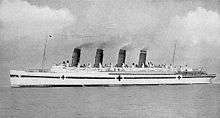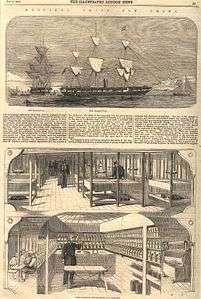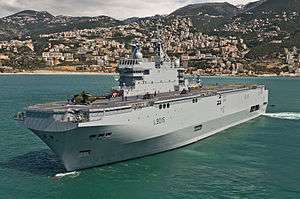Hospital ship
_in_Hati.jpg)

A hospital ship is a ship designated for primary function as a floating medical treatment facility or hospital. Most are operated by the military forces (mostly navies) of various countries, as they are intended to be used in or near war zones.[1]
Although attacking a hospital ship is a war crime, belligerent navies have the right to board such ships for inspections.
History
Early examples
.jpg)
Hospital ships possibly existed in ancient times. The Athenian Navy had a ship named Therapia, and the Roman Navy had a ship named Aesculapius, their names indicating that they may have been hospital ships.
It was only during the 17th century that it became customary for naval squadrons to be accompanied by special vessels with the job of taking in the wounded after each engagement. The first known such vessel was the HMS Goodwill, commissioned in 1608 for the Royal Navy. Hospital ships were also used for the treatment of wounded soldiers fighting on land. An early example of this was during an English operation to evacuate English Tangier in 1683. An account of this evacuation was written by Samuel Pepys, an eyewitness. One of the main concerns was the evacuation of sick soldiers "and the many families and their effects to be brought off". The hospital ship Unity and Welcome sailed for England on 18 October 1683 with 114 invalid soldiers and 104 women and children, arriving at The Downs on 14 December 1683.[2]
On 8 December 1798, unfit for service as a warship, HMS Victory was ordered to be converted to a hospital ship to hold wounded French and Spanish prisoners of war. According to Edward Hasted in 1798, two large hospital ships (also called lazarettos), (which were the surviving hulks of forty-four gun ships) were moored in Halstow Creek in Kent. The creek is an inlet from the River Medway and the River Thames. The hospital ships watched over ships coming to England which were forced to stay in the creek under quarantine to protect the country from infectious diseases including the plague.[3]
Modern hospital ships

The institutionalization of the use of hospital ships by the Royal Navy occurred during the first half of the nineteenth century. By the standard of the medical provision available at the time for convalescent soldiers, hospital ships were generally superior in their standard of service and sanitation. It was during the Crimean War in the 1850s that the modern hospital ship began to emerge. The only military hospital available to the British forces fighting on the Crimean Peninsula was at Scutari near the Dardanelles. Over the course of the Siege of Sevastopol, almost 15,000 wounded troops were transported there from the port at Balaklava by a squadron of converted hospital ships.[2]
The first ships to be equipped with genuine medical facilities, were the steamships HMS Melbourne and HMS Mauritius. These hospitals were manned by the Medical Staff Corps and provided services to the British expedition to China in 1860. The ships provided relatively spacious accommodation for the patients and were equipped with an operating theatre. Another early example of a hospital ship was USS Red Rover in the 1860s, which aided the wounded soldiers of both sides during the American Civil War.[2]
During the Russo-Turkish War (1877–78), the British Red Cross supplied a steel-hulled ship, equipped with modern surgery equipment including chloroform and other anaesthetics and carbolic acid for antisepsis. Similar vessels accompanied the 1882 invasion of Egypt and aided American personnel during the Spanish–American War.[2]
Hospital ships were used by both sides in the Russo-Japanese War (1904–05). It was the sighting by the Japanese of the Russian hospital ship Orel, correctly illuminated in accordance with regulations, that led to the decisive naval Battle of Tsushima. Orel was retained as a prize of war by the Japanese after the battle.
World Wars

During World War I and World War II, hospital ships were first used on a massive scale. Many passenger liners were converted for use as hospital ships. RMS Aquitania and HMHS Britannic were two famous examples of ships serving in this capacity. By the end of the First World War, The British Royal Navy had 77 such ships in service. During the Gallipoli Campaign, hospital ships were used to evacuate over 100,000 wounded personnel to Egypt.
Canada operated hospital ships in both world wars. In World War I these included the SS Letitia (I) and HMHS Llandovery Castle which was deliberately sunk by a German U-Boat with great loss of life, despite the hospital ship's clearly marked status. In World War II, Canada operated the hospital ship RMS Lady Nelson and SS Letitia (II).[4]
The first purposely built hospital ship in the U.S. Navy was the USS Relief[5] which was commissioned in 1921. During World War II both the United States Navy and Army operated hospital ships though with different purposes.[6] Naval hospital ships were fully equipped hospitals designed to receive casualties direct from the battlefield and also supplied to provide logistical support to front line medical teams ashore.[6] Army hospital ships were essentially hospital transports intended and equipped to evacuate patients from forward area Army hospitals to rear area hospitals or from those to the United States and were not equipped or staffed to handle large numbers of direct battle casualties.[6] Three of the Navy hospital ships, USS Comfort, USS Hope, and USS Mercy, were less elaborately equipped than other Navy hospital ships, medically staffed by Army medical personnel and similar in purpose to the Army model.[6]
The last British royal yacht, the post World War II HMY Britannia, was ostensibly constructed in a way as to be easily convertible to a hospital ship, but this is now thought to be largely a ruse to ensure Parliamentary funding, and she never served in this role – reputedly her lifts were too small to take standard-sized stretchers.
A development of the Lun-class ekranoplan was planned for use as a mobile field hospital for rapid deployment to any ocean or coastal location at a speed of 297 knots (550 km/h). Work was 90% complete on this model, the Spasatel, but Soviet military funding ceased and it was never completed.
Some hospital ships, such as the SS Hope and Esperanza del Mar, belong to civilian agencies, and as such are not part of any navy. Mercy Ships, an international charity, do not belong to any government.
International law

Hospital ships were covered under the Hague Convention X of 1907.[7] Article four of the Hague Convention X outlined the restrictions for a hospital ship:
- Ship must be clearly marked and lighted as a hospital ship
- The ship should give medical assistance to wounded personnel of all nationalities
- The ship must not be used for any military purpose
- The ship must not interfere with or hamper enemy combatant vessels
- Belligerents, as designated by the Hague Convention, can search any hospital ship to investigate violations of the above restrictions
- Belligerents will establish the location of a hospital ship
According to the San Remo Manual on International Law Applicable to Armed Conflicts at Sea, a hospital ship violating legal restrictions must be duly warned and given a reasonable time limit to comply. If a hospital ship persists in violating restrictions, a belligerent is legally entitled to capture it or take other means to enforce compliance. A non-complying hospital ship may only be fired on under the following conditions:
- Diversion or capture is not feasible
- No other method to exercise control is available
- The violations are grave enough to allow the ship to be classified as a military objective
- The damage and casualties will not be disproportionate to the military advantage.
In all other circumstances, attacking a hospital ship is a war crime.
Modern hospital ships display large Red Crosses ![]() or Red Crescents
or Red Crescents ![]() to signify their Geneva Convention protection under the laws of war. Even so, marked vessels have not been completely free from attack. Notable examples of hospital ships deliberately attacked during wartime are HMHS Llandovery Castle in 1915, the Soviet hospital ship Armenia in 1941 and AHS Centaur in 1943.
to signify their Geneva Convention protection under the laws of war. Even so, marked vessels have not been completely free from attack. Notable examples of hospital ships deliberately attacked during wartime are HMHS Llandovery Castle in 1915, the Soviet hospital ship Armenia in 1941 and AHS Centaur in 1943.
Current hospital ships




Both ships are operated by Military Sealift Command. Their primary mission is to provide emergency on-site care for U.S. combatant forces deployed in war or other operations. The ships' secondary mission is to provide full hospital services to support U.S. disaster relief and humanitarian operations worldwide.
Each ship contains 12 fully equipped operating rooms, a 1,000-bed hospital facility, digital radiological services, a medical laboratory, a pharmacy, an optometry lab, an intensive care ward, dental services, a CT scanner, a morgue, and two oxygen-producing plants. Each ship is equipped with a helicopter deck capable of landing large military helicopters. The ships also have side ports to take on patients at sea.
- Pará class - Amazon River hospital ship U15 Pará.
- Doutor Montenegro class - Amazon River hospital ship U16 Doutor Montenegro.
- Oswaldo Cruz class - Amazon River hospital ships U18 Oswaldo Cruz and U19 Carlos Chagas.
- Carlos Chagas class - Amazon River hospital ship U19 Carlos Chagas.
- Soares de Meirelles class - Amazon River hospital ship U21 Soares de Meirelles.
- Tenente Maximiano class - Amazon River hospital ship U28 Tenente Maximiano.
- Nankang class hospital ship - 2 ships, Nankang and Nanyun. Former Qiongsha class troop transport ships modified as hospital ships in the 1980s.
- Zhuanghe - a converted container ship capable of being fitted out for various roles. When fitted with medical facilities it is officially classed as a "medical evacuation ship".
- Daishandao, also known as Peace Ark in peacetime - a converted cruise ship with 300 hospital beds, 20 intensive care units and 8 operating theatres.
- Project 320 - Former Russian hospital ship Ob built in 1980, purchased in 2007.
- KRI Dr Soeharso - former landing ship converted to a hospital ship in 2007.
- BAP Puno - Former passenger and cargo ship built in 1861, converted to a hospital ship in 1976. Operates on Lake Titicaca.
- Ob' class - 3 ships Irtysh, Svir and Yenisey built between 1981 and 1990. Each has 7 operating rooms, 100 hospital beds and a helipad. Operated by civilian crews but with naval medical staff. Class leader Ob built in 1980, stricken in 1997 and sold to China in 2007.
- Esperanza del Mar - purpose-built hospital ship commissioned in 2001 to provide medical services to the Spanish industrial fishing fleet.
- Juan de la Cosa - hospital ship commissioned in 2006 to provide medical services to the Spanish industrial fishing fleet and offer technical and logistical support to the Spanish Navy.
- Hospital Ship Khánh Hòa 01 (HQ-561) contains 20 hospital beds and has about 12 medical staff
- Non-government
- MV Africa Mercy - A former ferry fitted converted to a hospital ship in 2007 for Mercy Ships. The world's largest non-governmental floating hospital.
Other shipborne hospitals
.jpg)
It is common for naval ships, especially large ships such as aircraft carriers and amphibious assault ships to have on-board hospitals. However, they are only one small part of the vessel's overall capability, and are used primarily for the ship's crew and its amphibious forces (and occasionally for relief missions). They do not qualify as "hospital ships", as they are not marked and designated as such, and as armed vessels they are disqualified from protection as a hospital ship under international law.[8] Examples of these ships from various navies include;
Several classes of US Navy ships are equipped with on-board hospitals;
- Nimitz-class aircraft carrier – Each carrier has a 53-bed hospital ward, a three-bed ICU, and acts as the hospital ship for the entire carrier strike group.[9] In one year, the medical department of the USS George Washington handled over 15,000 out-patient visits, drew almost 27,000 labs, filled almost 10,000 prescriptions, took about 2,300 x-rays and performed 65 surgical operations.[10] There is not much variation among the ships of the class. The first ship, USS Nimitz has 53 beds, plus 3 ICU beds, and the last ship, USS George H.W. Bush has 51 beds, plus 3 ICU beds.[11]
%3B10080504.jpg)
- Wasp-class amphibious assault ship (LHD) – These ships have 6 operating rooms, 14 ICU beds, 46 hospital beds, 4 battle dressing stations, medical imaging (i.e.:X-ray), a fully functional laboratory, and a blood bank.[12] The ship can expand its medical complement to 600 beds, making it the second largest hospital at sea, second only to actual hospital ships.[13]
- America-class amphibious assault ship (LHA) – This is the newest and largest class both in the USN and the world. However, the first two ships of the class, USS America and USS Tripoli, had the size of their medical facilities reduced, in favour of larger aviation facilities.[14] The on-board hospitals of these first two vessels will have 2 operating rooms and 24 beds.[15] It is unknown if this design change will affect the expanded capability for additional beds, nor what size the medical facilities of future ships of the class will be.
- San Antonio-class amphibious transport dock (LPD) – 24 hospital beds.[15]
- Harpers Ferry-class dock landing ship (LSD) – 11 hospital beds.[15]
- Whidbey Island-class dock landing ship (LSD) – 8 hospital beds.[15]
- Royal Fleet Auxiliary ship RFA Argus – This ship would be a hospital ship were it not for its armaments. However, it is instead designated as a 'Primary Casualty Receiving Ship' (PCRS).
- Several armed Qiongsha-class cargo ships are fitted out as as "ambulance transports".
- Shichang - a multi-role training ship built in 1997. Deck space can accommodate modular medical units and can be used as a medical treatment facility, but the primary role is aviation training. The layout is very similar to RFA Argus (see above).

- Mistral-class Amphibious assault ship – On board hospital is NATO Echelon level-3,[16] with 69 hospital beds, 7 ICU beds, and an additional 50 beds if needed. The ship also has medical imaging capabilities, such as X-ray, CT-scan and ultrasound.
- ARA Almirante Irízar - Icebreaker which can be deployed as a hospital ship.
- ESPS Juan Carlos I – Has a 40-bed hospital on board.[17]
- Canberra-class Landing helicopter dock – This class is based on the Juan Carlos I class design,[18] and has 2 operating rooms and a hospital ward.[19]
See also
- Lists
- List of Australian hospital ships
- List of Chinese Navy hospital ships
- List of hospitals and hospital ships of the Royal Navy
- Hospital Ships of the Sanitary Commission
- List of United States Army hospital ships
- List of US Navy hospital ships
- List of Brazilian Navy hospital ships
- List of hospital ships sunk in World War I
- List of hospital ships sunk in World War II
- Other
References
- ↑ Hospital Ship (definition via WordNet, Princeton University)
- 1 2 3 4 Jack Edward McCallum (2008). Military Medicine: From Ancient Times to the 21st Century. ABC-CLIO. pp. 150–152.
- ↑ Hasted, Edward (1799). "Parishes". The History and Topographical Survey of the County of Kent. Institute of Historical Research. 6: 34–40. Retrieved 28 February 2014.
- ↑ Douglas N. W. Smith, "Bringing Home the Wounded", Canadian Rail Passenger Yearbook 1996-1997 Edition, Trackside Canada, Ottawa, p. 49-64.
- ↑ "Modern Hospital Sails With U.S. Fleet." Popular Science Monthly, August 1927, p. 35.
- 1 2 3 4 Condon-Rall, Mary Ellen; Cowdrey, Albert E. (1998). The Technical Services—The Medical Department: Medical Service In The War Against Japan. United States Army In World War II. Washington, DC: Center Of Military History, United States Army. pp. 258, 388–389. LCCN 97022644.
- ↑ "Convention for the adaptation to maritime war of the principles of the Geneva Convention". Yale University. October 18, 1907. Retrieved August 2, 2009.
- ↑ John Pike. "World Wide Hospital Ships". globalsecurity.org. Retrieved 4 May 2015.
- ↑ "CARRIER . The Ship - PBS". pbs.org. Retrieved 4 May 2015.
- ↑ Harwood, Jared L.; Pothula, Viswanadham (April 2011). "The USS George Washington medical department: Medicine in motion" (PDF). Bulletin of the American College of Surgeons. 96 (4). Archived from the original (PDF) on 19 May 2011.
- ↑ "Departments". navy.mil. Retrieved 4 May 2015.
- ↑ "USS WASP". navy.mil. Retrieved 4 May 2015.
- ↑ John Pike. "LHD-1 Wasp class". globalsecurity.org. Retrieved 4 May 2015.
- ↑ "LHA 6 (formerly LHA(R)) : New Amphibious Assault Ship" (PDF). Dote.osd.mil. Retrieved 2016-03-09.
- 1 2 3 4 "Amphibious Ready Group and Marine expeditionary Unit Overview" (PDF). Imef.marines.mil. Retrieved 2016-03-09.
- ↑ "NATO Logistics Handbook: Chapter 16: Medical Support". nato.int. Retrieved 4 May 2015.
- ↑ "The Aviationist » L61 Juan Carlos I". theaviationist.com. Retrieved 4 May 2015.
- ↑ La Opinión de A Coruña. "Navantia efectúa con éxito el ´encaje´ del ´Canberra´". laopinioncoruna.es. Retrieved 4 May 2015.
- ↑ John Pike. "Canberra Class Amphibious Ship". globalsecurity.org. Retrieved 4 May 2015.
This article incorporates text from the public domain Dictionary of American Naval Fighting Ships. The entry can be found here.
External links
- Australian War Memorial - Sinking of the Centaur
- WW2 US Hospital Ships
- US Army Hospital Ships in WWII
- New Zealand Hospital Ships (chapter of official history of WWI)
![]() Media related to Hospital ships at Wikimedia Commons
Media related to Hospital ships at Wikimedia Commons
